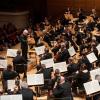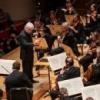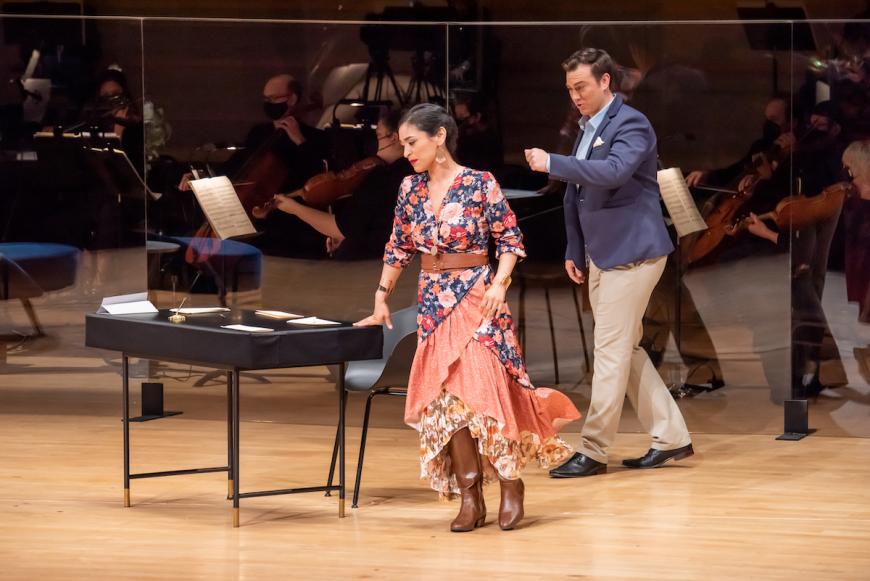
Until grand opera returns to stages at full strength, ventures such as Pacific Symphony’s semi-staged La traviata will have to do. And in this case, even under limitations imposed by COVID-19, do very nicely. By turns intimate and intense, lyrical and raw, the production delivers Verdi’s tragic masterwork in ways both familiar and inventively fresh. It’s available for streaming at $25 per household through July 4.
Filmed at the ensemble’s Orange County home, the Renée and Henry Segerstrom Concert Hall, the tale of doomed love is streamlined to a running time of 94 minutes, with a cast of five handling all the vocal assignments. Music Director Carl St. Clair conducts a socially distanced orchestra, positioned onstage and discreetly cloaked in shadow.
Pacific Symphony has been mounting semi-staged operas for the past decade, under its Opera Vocal Initiative, and the experience shows. Singers and the orchestra are in fluid sync. Stage director Robert Neu’s instincts are both sound and dramatically effective, in matters of blocking, entrances, and exits. The minimal settings and props (a daybed, a desk) are smartly used.
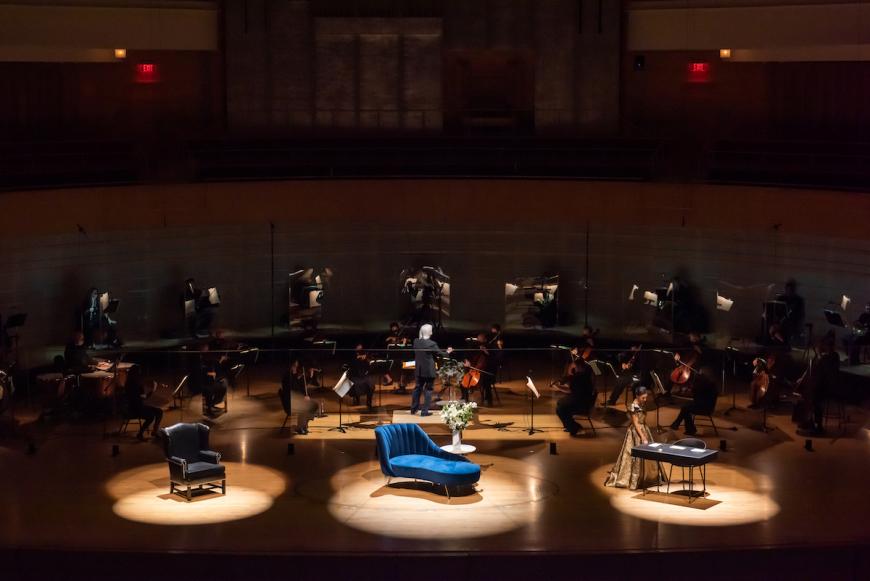
It’s one thing to pull off a concertized opera in front of a live audience, and quite another to make it work onscreen, with multiple cameras scrutinizing the action. Add to the degree of difficulty the constraint that the singers, while unmasked, never make physical contact with each other. It’s the Touchless Traviata.
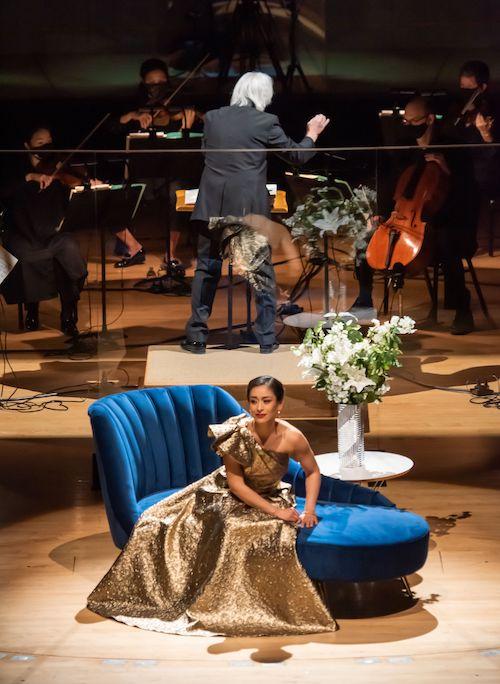
Thanks to persuasively vivid performances by soprano Cecilia Violetta López as the sickly courtesan Violetta and tenor John Riesen as her volatile suitor Alfredo, the couple feels tightly bound from start to finish. While no stage director would choose to have the two lovers keep their distance, there is a certain heightening effect to it here. It’s their emotion-charged voices and dramatic presences that mingle. What their bodies do and mean to each other is unambiguously implied.
After a perky “Libiamo” champagne toast and some winking matchmaking by Alfredo’s pal Gaston (a versatile Matthew Kellaway in one of multiple supporting roles), López and Riesen get the sparks flying. With her lustrous voice, a flair for unbroken long lines, and smoldering good looks, this Violetta is a deep well of emotion. She may be physically vulnerable — a fact López may deliver a little too often by gripping her midsection — but her amorous spirit is very willing.
Riesen, with his youthfully blooming tenor and beamish face, comes off as an eager innocent who falls hard and fast for a woman he’s drawn to but doesn’t quite fathom. That lays the ground work for his wounded anger at her apparent betrayal later on.
St. Clair gives the two principals plenty of time and space to connect, with their respective arias played out in leisurely, even languid tempos. Attending to Alfredo’s offstage exaltation, López’s Violetta vaults to almost recklessly ecstatic high notes in “Sempre libera.”
Riesen is still on a roll as the second act begins, all but belting out his infatuation. His father, Germont, of course, has other plans. Baritone Jeffrey Mattsey sings the rueful but determined father figure in a performance that’s slow to emerge. There’s something opaque and lidded about his first appeal to Violetta to let his son go, tactical to a fault. Later, in a quietly anguished “Di Provenza il mar,” Mattsey gradually comes into his own.
This Traviata gets its most substantial cuts in the second act, a good portion of which is devoted to a party and gambling scene that a chamber cast could only approximate. What remains, however, is fleet and blunt. His brow furrowed, voice fibrous, and body tense with anger, Alfredo flings his gambling winnings at Violetta in a violent frenzy. It’s a powerful, frightening moment.
The final act spools out in an unbroken skein of pain, regret, hope, and desolation. It opens with a gesture that the camera’s close-up delivers to piercing effect. Wiping away her lipstick and removing her earrings, Violetta leaves her sybaritic life behind and shrinks down onto the bed where she will die. It’s a collapse of the body and a spiritual expansion.
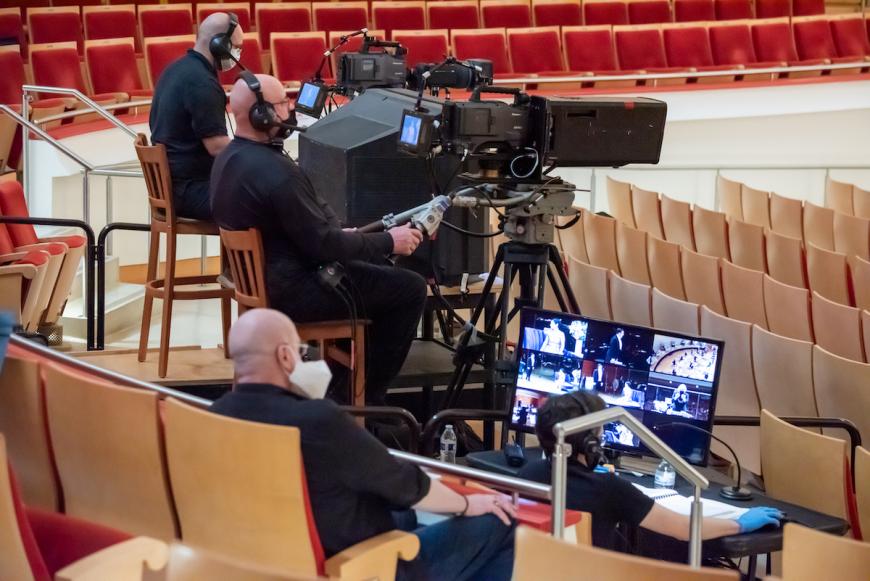
Verdi’s genius is on full display in the scene that reunites Alfredo and Violetta at the end. Their vocal lines both match and mirror in bittersweet echoes of music from their lovestruck early days. López and Riesen are splendid here. Her “Addio del passato” is like life itself passing from her in a long exhale. A lovers’ duet of escape to Paris is a poignant fantasy.
The production’s final image, which viewers should discover on their own, is a small coup de théâtre that brings this well-conceived and executed La traviata to a fittingly resonant close.


